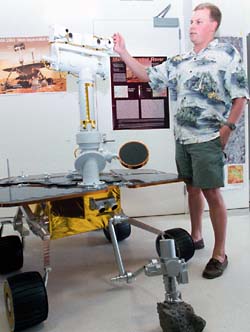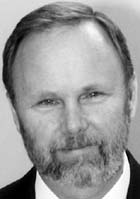Two robotic field geologists are hurtling toward Mars on separate launch vehicles to provide answers to questions on the planet’s climate and water history.
Sixteen people at the University, from undergraduate students to full professors, are fully involved in the mission. They helped NASA determine the landing sites for the rovers — Spirit and Opportunity — and will assist in the analysis of the data collected.

The launch of Spirit (June 10) and Opportunity (July 7) marks the National Aeronautics and Space Administration’s first return to the planet’s surface since the 1997 Pathfinder Mission.
When assessing possible landing sites, NASA turned to one of its veterans, Raymond E. Arvidson, Ph.D., the James S. McDonnell Distinguished University Professor and chair of the Department of Earth and Planetary Sciences. Arvidson is deputy principal investigator for the Athena Science Payload, which is the total science endeavor of the missions.
“We’ve been trying to get a mission like this to fly for seven years,” Arvidson said.
During that interval, Arvidson and his University and national colleagues have been busily involved with something called “site selection and certification.”
“We have to make sure the site is scientifically exciting and also safe in terms of landing hazards,” Arvidson said. “Lots of big, pointy rocks, for example, would puncture the air bags. There can’t be any big cliffs nearby that the landing site could impact.”
In order to make sure the site was safe, Arvidson and his team helped by first using information from orbiters — the Mars Global Surveyor and Odyssey — to hone in on areas that looked scientifically interesting.
“These rovers were designed to understand whether or not water was on the surface and interacted with the crust to produce aqueous minerals,” Arvidson said. “We wanted to find places where we could test hypotheses that relate to the presence of water on the surface or beneath the surface. This is at the core of determining whether or not Mars was once habitable for life, since water is a crucial element for life.”
One such site is the Meridiani Planum, where Opportunity is set to land Jan. 25. Arvidson noted that the plains show evidence of an iron oxide mineral called “hematite” that may have formed in old lake beds, or the deposits could consist of a layer within a thick set of volcanic deposits that has been hydrothermally altered.

Either way, the landscape looks ripe with the possibility of ancient hydrological evidence.
The Spirit will visit the other landing site, the floor of Gusev Crater, which sits at the opposite side of the planet from the Meridiani Planum. The crater also promises to be a spot rich in evidence for ancient climatic conditions.
Both landing sites are situated near the equator, a necessary position for the two solar-powered rovers.
Graduate student Frank Seelos is one of those from the University involved with the rover mission besides Arvidson, who leads the group. Seelos has spent considerable time since 2001 analyzing the mineralogy and geological history of the landing sites, especially the Meridiani Planum.
When the rovers land early next year, Seelos will be a collaborator for the Athena Science Payload team, making early, real-time analyses generated from the image data. He’ll spend some time at the Jet Propulsion Laboratory (JPL) in Pasadena, Calif., and then return to the University.
“I’m anticipating a very exciting, very busy time,” said Seelos, who plans to earn a doctorate in the spring. “I feel very fortunate to be at the right place at the right time and to have the right adviser, who’s provided me with this great opportunity.”
Once the rovers land, they will immediately begin collecting data. Panoramic cameras will provide a 360-degree view of the surface, as well as help determine sites for closer inspection. A rock abrasion tool sits on the end of a long arm and is used to expose the unaltered interiors of rocks.
Another instrument, known as “mini-TES” (thermal emission spectrometer), will scan the scene in infrared to help identify regions where water may have interacted with the surface. Similarly, the Moessbauer spectrometer will be used to identify rocks containing iron and determine what role water may have played in that mineral’s formation.
An alpha particle X-ray spectrometer will measure elements in the rocks and soil, and a microscopic imager will look at fine-scale features of rocks and sediment deposited by water.
The information will be relayed back to Earth in one of two ways. The “direct to Earth” antenna is a high-gain transmitter that both sends and receives data. Another antenna, called a “dipole,” communicates with Mars Global Surveyor and Odyssey. The orbiters have much more powerful antennas and can transmit data to Earth more quickly.
Arvidson plans to work full-time at JPL once the mission is under way. He will also be working as a distinguished visiting scientist at JPL, providing strategic advice for the program.
“We have a role in operations called ‘science analysis,'” Arvidson said. “It costs $4.5 million a day to be up there, so we have to make sure we’re optimizing the system.”
One way to do that, Arvidson noted, is through documentation.
“Each day, the scientists at JPL will prepare a data package which can be transferred back to Washington University via the Internet and used to create what’s called an ‘analyst’s notebook.’ Once we have everything together and validated, the notebooks open to the public as a formal archive.”
“In addition, all the images that we collect will be streamed to the Web as soon as they’re processed. So the world will see them, typically, before the team does.”